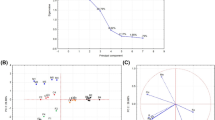Abstract
We propose a technique for classifying paints with time-dependent properties using a new method of merging principal-component analyses (the “PCA-merge” method) that utilizes shifting of the barycenter of the PCA score plot. To understand the molecular structure, elemental concentrations, and the concentrations in the evolved gaseous component of various paints, we performed comprehensive characterizations using Fourier transform infrared spectroscopy, inductively coupled plasma mass spectrometry, and head-space–gas chromatograph/mass spectrometry while drying the paint films for 1–48 h. As various detected intensity- and time-axis variables have different dimensions that cannot be handled equally, we normalized those data as an angle parameter (θ) using arctangent to reduce the influence of high/low intensity data and the various analytical instrument. We could classify the paints into suitable categories by applying multivariate analysis to this arctangent-normalized data set. In addition, we developed a new PCA-merge method to analyze data groups that include different time components. This method merges the PCA data groups of each time-component axis into that of specific-component axes and distinguishes each sample by utilizing the shift in the barycenter of the PCA score plot. The proposed method enables the simultaneous utilization of various data groups that contain information about static and dynamic properties. This provides further insight into the characteristics of the paint materials via shifts in the barycenter of the PCA scores without requiring numerous peak identifications.
Graphical abstract








Similar content being viewed by others
Data availability
The datasets generated during and/or analyzed during the current study are available from the corresponding author on reasonable request.
References
Y. Nishimoto, H. Eguchi, E. Shimoda, T. Suzuki, Anal. Sci. (2015). https://doi.org/10.2116/analsci.31.929
JIS K 5500:2000 Glossary of terms for coating materials. https://kikakurui.com/k5/K5500-2000-01.html
T. Suzuki, K. Takahashi, H. Uehara, T. Yamanobe, J. Therm. Anal. Calorim. (2013). https://doi.org/10.1007/s10973-013-3098-z
R. Bro, A.K. Smilde, Anal. Methods. (2014). https://doi.org/10.1039/C3AY41907J
M. Isshiki, S. Nakamura, Y. Suzuki, Nippon Shokuhin Kagaku Kogaku Kaishi (2015). https://doi.org/10.3136/nskkk.62.257
M.J. Latorre, Food Chem. (1999). https://doi.org/10.1016/S0308-8146(98)00217-9
M.J.J. Baxter, H.M. Crews, M. John-Dennis, I. Goodall, D. Anderson, Food Chem. (1997). https://doi.org/10.1016/S0308-8146(96)00365-2
Y. Murakami, H. Iwabuchi, Y. Ohba, H. Fukami, J. Oleo Sci. (2019). https://doi.org/10.5650/jos.ess19155
S.D. Rodríguez, M. Gagneten, A.E. Farroni, N.M. Percibaldi, M.P. Buera, Food Cont. (2019). https://doi.org/10.1016/j.foodcont.2019.05.025
G. Squeo, S. Grassi, V.M. Paradiso, C. Alamprese, F. Caponio, Food Cont. (2019). https://doi.org/10.1016/j.foodcont.2019.03.027
D. Granato, J.S. Santos, G.B. Escher, B.L. Ferreira, R.M. Maggio, Trends Food Sci. Technol. (2018). https://doi.org/10.1016/j.tifs.2017.12.006
M. Maric, W. van Bronswijk, S.W. Lewis, K. Pitts, D.E. Martin, Forensic Sci. Int. (2013). https://doi.org/10.1016/j.forsciint.2013.01.032
R. Chophi, S. Sharma, R. Singh, Forensic Chem. (2020). https://doi.org/10.1016/j.forc.2019.100209
N.Z. Shafii, A.S.M. Saudi, J.C. Pang, I.F. Abu, N. Sapawe, M.K.A. Kamarudin, H.F.M. Saudi, Heliyon. (2019). https://doi.org/10.1016/j.heliyon.2019.e02534
M. Quinn, T. Brettell, M. Joshi, J. Bonetti, L. Quarino, Forensic Sci. Int. (2020). https://doi.org/10.1016/j.forsciint.2019.110135
X. Ran, Y. Xi, Y. Lu, X. Wang, Z. Lu, Artif. Intell. Rev. (2022). https://doi.org/10.1007/s10462-022-10366-3
T. Tanji, M. Furukawa, S. Taguma, K. Fujimoto, H. Sato, N. Shibasaki, Y. Takagai, ACS ES&T Water (2023). https://doi.org/10.1021/acsestwater.2c00455
K. Kobayashi, Y. Niida, M. Furukawa, O. Shikino, M. Furuishi, T. Suzuki, Eng. Mater. (THE NIKKAN KOGYO SHIMBUN Japan 67(9), 50–51 (2019)
T. Suzuki, N. Sokutei, (2020) https://doi.org/10.11311/jscta.47.4_148
G.E.P. Box, G.M. Jenkins, G.C. Reinsel, Time series analysis: forecasting and control (Wiley, Hoboken, 2016). (978-1-118-63434-9)
B.P. Geurts, A.H. Neerincx, S. Bertrand, M.A.A.P. Leemans, G.J. Postma, J.L. Wolfender, S.M. Cristescu, L.M.C. Buydens, J.J. Jansen, Anal. Chim. Acta. (2017). https://doi.org/10.1016/j.aca.2017.01.064
T. Morishita, J. Chem. Phys. (2021). https://doi.org/10.1063/5.0061874
Funding
None.
Author information
Authors and Affiliations
Corresponding author
Ethics declarations
Conflict of interest
There are no conflicts to declare.
Supplementary Information
Below is the link to the electronic supplementary material.
Rights and permissions
Springer Nature or its licensor (e.g. a society or other partner) holds exclusive rights to this article under a publishing agreement with the author(s) or other rightsholder(s); author self-archiving of the accepted manuscript version of this article is solely governed by the terms of such publishing agreement and applicable law.
About this article
Cite this article
Furukawa, M., Niida, Y., Kobayashi, K. et al. Arctangent normalization and principal-component analyses merge method to classify characteristics utilizing time-dependent material data. ANAL. SCI. 39, 1957–1966 (2023). https://doi.org/10.1007/s44211-023-00403-8
Received:
Accepted:
Published:
Issue Date:
DOI: https://doi.org/10.1007/s44211-023-00403-8




